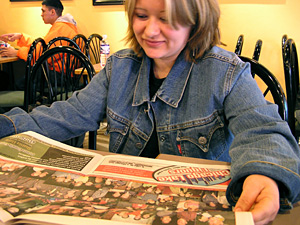March 28, 2005
 |
| Jenifer Garcia, 27, is looking at the social pages of VidaSabor, a biweekly Spanish-language paper distributed in the Twin Cities. The social pages feature celebrity-style photos of young people posing during a night out at a local bar or dance club. Jenifer gets excited when she recognizes someone she knows. (Bianca Vazquez Toness) |
Minneapolis, Minn. — Jenifer Garcia and Christina Avila are eating lunch at the Mercado Central in Minneapolis. They push aside the empty bowls of pozole, a soup of hominy and pork from their native Mexico.
The two lean close. The latest issue of VidaSabor is splayed out before them on the table.
The two women run their fingers down the entertainment calendar. They compare the dance spots around town, where they play salsa or regueton. They get excited when they see a Santana concert planned for the Spring.
Jenifer and Cristina live and work in the suburbs. But they make special trips to the city to plug into the growing Latino community on Lake Street.
"We like reading these magazines because you see what's going on," Jenifer says. "We can find places where there's a good scene, places where we can meet other Latinos."
VidaSAbor started up five years ago. Its title suggests the contents will add flavor to a readers' life. The biweekly tabloid is aimed at Latinos between 18 and 25.
VidaSabor is one of about a dozen Spanish-language or bilingual publications in the Twin Cities.
The growth in the market followed a boom in the Latino population here. The population grew 166 percent during the 1990s and is still on the rise. The publications try to appeal to different niches within the community.
There's a glossy magazine aimed at what Spanish-speakers call "yoopies" or yuppies. But most of the publications are weekly newspapers with news but mostly ads. The oldest publication has been around for 15 years.
Juan Carlos Alanis, the publisher of VidaSabor and three other Spanish-language publications, started out in tiny quarters. But now his company and its office space have gone upscale. The space is modern, open and bright. It looks successful.
Now Alanis is worried about competition.
"The challenge is to do what we are doing with the same quality and the same resources, knowing that the guy next door is doing the publication in the basement of their house or in an apartment with no expenses," he says. "We have a payroll of 15 people every two weeks. These guys have no payroll, at all. If they make a buck, that's fine. But that's a challenge. I think the fact that we are producing good products is helping us a lot."
Competition in the Spanish-language media market is on the rise and much of it is coming from familiar faces. Miguel Ramos used to work with Alanis. Now he publishes ViceVersa. It's a quarterly magazine focused on culture and politics. Like in any industry, the marketplace decides who survives. Ramos wonders which of the existing Spanish-language publications will make it.
"We have more papers than are necessary," he says. "But I say everyone has a right to try and make their dream come true whether it's a restaurant or magazine. Some won't survive. Hopefully we will. But the readers, or listeners, or businesses should decide."
But advertisers may not like having to decide. Ricardo Vallejos owns Latino Creative.com, a local Hispanic advertising company, says there aren't many companies advertising in the Latino media here. The ones that do have small budgets.
"As an advertiser, when you want to advertise in Latino media if you wanted to have 100 percent share of voice, you are going to spend a lot of money," he says. "It's not going to be effective. Very few companies do that. Almost none. Because you can't. In many other markets our size there are only one or two print media vehicles. You can advertize in both and have effectively 100 percent share of voice in Latino media. In this town you cannot do that."
Many of the publishers expected Minnesota companies like utilities, banks and grocery stores to advertise in Spanish. That hasn't been the case. They depend instead on small Latino businesses.
That makes it tough to find new customers and ad dollars.
Because many of these Spanish-language media folks know each other, the competition isn't just business. It's personal. Although no one will say it on the record, they claim that competitors steal copies of their papers from the racks where they are distributed for free. They accuse one another of inflating circulation numbers, not to mention plagiarism.
But their biggest competition may not be other publications, but radio and television.
Miguel Ramos, the publisher of ViceVersa, is branching out into radio. He and some partners just changed the format of a Christian radio station into a Spanish-language music station. Before January, you could only hear La Que Buena on FM 107.5 from 9 p.m. to 5 a.m.
Now it's on all of the time. So when you scan through the FM stations in the Twin cities you may bump into Mexican Ranchera music or Cumbia from Venezuela.
Ramos is proud of the station, but jokes that he doesn't want to offend God for taking him off the air.
And if the first Spanish-language FM station isn't enough, there's something larger on the horizon.
Univision is here.
The Los Angeles based network started a Twin Cities affiiliate in January. Univision just started selling local advertising and plans to begin local news coverage this summer.
Publishers worry about sharing an already small advertising base with this giant. But they're encouraged that the Latino population has grown fast enough to attract such a big player.






